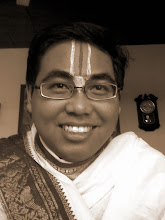You may take my opinion or not, but this is what I felt about this great personage. He was one who realized Kalinga (ancient Orissa) origin Vajrayana siddhantas (theologic conclusions) and worshipper of Lord Jagannathdeva. In one sense, Lord Jagannathdeva is The Supreme Deity of Vaishnavas, The Paravasudeva, who emenates as Three Divine Forms and further became the source of The Tri Nathas (Brahma, Vishnu, Siva). This tenets established by mPu Kuturan in Bali, and long before him by the Kings and Sages of Central Java Sanjaya Dynasty. But in the same time Lord Jagannathdeva was also worshiped by the Tantrayanic or Mantrayanic or Vajrayanic Buddhist as Adi Buddha or The Original Buddha, as we found in Indrabhuti's Book of Jnanasiddhi. (Indrabhuti of Orissa himself was considered as the propagator of Vajrayana Buddhism and his sister Siddha Yogini Laksminkara was the preceptor of Sahajayana).
From this complex spiritual practices and beliefs we have the cult of Mahavairochana as the Adi Buddha. The cult of Mahavairochana reached Indonesia, China, Korea, and Japan by King Subhakarasingha's effort of Orissa. The Supreme Buddha Jagannathdeva of Indrabhuti took His new shape as Lord Mahavairochana Buddha of Mahavairochana Sutra. The most important sacred and confidential teachings of Mahavairochana cult were the meditational Mandala of Vajradhatu and Mahakarunagarbhodbhava, and also the treatise of iconography called Sarvatathagatasara-samgraha. In Indonesia the Vajradhatu-mandala was the world famous Borobudur temple (Bhumisambharabuddhara) and Lord Mahavairochana offered worships at Mendut temple, the Mahavairochana-mandala. Lord Mahavairochana Buddha accompanied by Bodhisattva Padmapani Lokeshvara and Vajrapani were the source of Tri Nathas as explained in The Book of Tutur Sang Hyang Kamahayanikan Mantrayana. Now we got the same conclusion both for the Buddhism (Dharma Kasugatan) and Vaishnavism (Dharma Kabhujanggan).
Now let we considered another fact. For years common peoples and archaeologist speculated about what is actually contained in the biggest Stupa of Borobudur. Was it empty from the beginning? Was it contained very valuable golden Buddha statue inlaid with precious stones and has been stolen? Or what...?
In a classic Javanese literary work of called Serat Centhini, quoted by Pandji Winoto, we found these passages.Pupuh (Song) 105, pages 59-60, 2nd Book, verse 8-9
Verse 8
”Umiyat kurungan sela, tinarancang alus remit, nglebete kurungansela, isi rece geng satunggil, nanging panggarapneki, kinten-kinten dereng rampung, saranduning sarira, katha kang dereng cinawi, kang samya myat langkung eram ing werdaya"
Look a cage of stone, so smooth and elaborately made. Inside it there is a single Deity, so great and gigantic in size. But it looked not already finished. So much unsculpted part on its body. Who ever saw it will feel amaze in his heart!
Verse 9
“Mas Cobolang angandiko, Para durunane iki, reca agung tur neng puncak, teka tan lengkep ing warni, yen pancen durung dadi, iku banget mokalipun, baya pancen jinarag, embuh karepe kang kardi,mara padha udakarenen ing driya.”
Mas Cebolang (narrator) said: How could it be? Such a big Deity, placed on the topmost throne, but looked imperfect and unfinished. This is impossible (they were not able to finished it yet before put it in its place). What did they (the maker) think? Did they make it purposefully? Let us contemplate it in our heart.
The Prime Statue of The Supreme Adi Buddha Mahavairochana in the center of this three dimensional Mandala Vajradhatu was in the form of unfinished and imperfect sculpture. The Primordial One and The Ultimate Perfection Himself is in the form of imperfection. The scholar and archeologist DR. Stutterheim also has already estimated this fact. So, this have the same concept with the Divine Form of Lord Jagannathdeva in Puri, Orissa. We saw Him, physically, as imperfect and unfinished Deity.
 Sri Jagannathdeva is Lord Paravasudeva
Sri Jagannathdeva is Lord ParavasudevaBhagavan Krishna for the Vaishnavas,
The Supreme Absolute Truth,
The Ultimate Perfection, The Source of Everything,
but seem as an imperfect, weird Deity
 Mahavairochana emenating other Buddhas and Bodhisattvas
Mahavairochana emenating other Buddhas and Bodhisattvas Sri Sri Radha Krishna in Milana as Rasaraja Mahabhava
Sri Sri Radha Krishna in Milana as Rasaraja MahabhavaThe Supreme Enjoyer and The Ultimate Bliss
 Buddha in Milana or Yab Yum position with His Energy, symbolized The Ultimate Bliss
Buddha in Milana or Yab Yum position with His Energy, symbolized The Ultimate BlissNow I hope the mystery of Bhatara Hyang Rishi Barada has already solved ....

















No comments:
Post a Comment